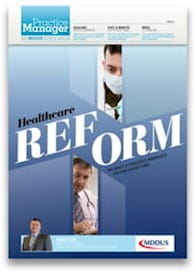HEALTH professionals deal with stress, day in and day out, advising and treating patients suffering from a variety of conditions ranging from mild anxiety through to major depression. The most recent UK statistics indicate that mental health is one of the top two reasons for absence from work, vying for first place with musculoskeletal disorders and accounting for more than 50 per cent of GP appointments.
Recent research also showed that NHS staff were four times as likely to be absent from work because of stress compared with other occupations, and that nurses were particularly at risk. The costs of stress can be high and, on top of sickness absence, can show up as high staff turnover, reduced work performance and poor timekeeping. And one employee’s stress can trigger stresses for their colleagues.
In any of its forms, poor mental health is a combined challenge for employers and employees alike. It is a complex health and safety issue as well as a human resources and employment law matter. Handled badly it can lead to personal injury claims, as well as allegations of disability discrimination and unfair dismissal.
No kind of workplace or work is immune from stress, but some, including healthcare settings, face particular risks if stress is not identified quickly and dealt with effectively. In a busy GP or dental practice, a stressed member of the administrative staff might fail to book appointments properly, record patient details incorrectly, forget to secure the premises when leaving or omit to transfer the telephone line to the out-of-hours service at the end of the working day.
Much more serious errors can be made by stressed practitioners, including mistakes in diagnosis, commencing inappropriate treatment, failing to interpret test results accurately and prescribing (and sometimes dispensing) either the wrong medication or the wrong dosage.
There is no such thing as a 'pressure-free' job. Every job brings its own set of tasks, responsibilities and day-to-day problems, and the pressures and demands these entail are an unavoidable part of working life. Staff are, after all, paid to work and to work hard, and to accept the reasonable pressures that go with that.
And some pressure can be a good thing. It is often the tasks and challenges we face at work that provide the structure to our working days, keep us motivated and contribute to a sense of achievement and job satisfaction. But people's ability to deal with pressure is not limitless. Excessive workplace pressure and the stress to which it can lead can be very harmful.
Unhealthy stress can involve physical effects, such as raised heart rate, increased sweating, headaches, dizziness, blurred vision, aching neck and shoulders, skin rashes and a lowering of resistance to infection. It also leads to increased anxiety and irritability, a tendency to drink more alcohol and smoke more, difficulty sleeping, poor concentration and an inability to deal calmly with everyday tasks and situations.
From a legal perspective employers have a duty to ensure employees are not made ill by their work. The Health and Safety Executive’s management standards are applicable to stress at work. They should be used to analyse work from six angles, as follows:
1. Demands – including issues such as workload, work patterns and the work environment.
2. Control – how much say the person has in the way they do their work.
3. Support – this includes the encouragement, sponsorship and resources provided by the organisation, line management and colleagues.
4. Relationships– this includes promoting positive working to avoid conflict and dealing with unacceptable behaviour.
5. Role – whether people understand their role within the organisation and whether the organisation ensures that they do not have conflicting roles.
6. Change – how organisational change (large or small) is managed and communicated in the organisation.
The enforcement authorities expect employers to meet their legal duties by implementing a five step process:
1. Identifying the risk factors.
2. Identifying who is potentially at risk.
3. Carrying out a formal risk assessment.
4. Recording the findings of the assessment.
5. Reviewing the issues periodically.
Staff themselves can provide a very useful view about the stress they are experiencing and the impact it is having on them, and many employers use anonymised questionnaires to gather this information. Even allowing for rogue results most staff will take this kind of exercise seriously and can alert management to issues they are unaware of.
A short article of this kind cannot go into the detail of how to keep on the right side of the law, but Law At Work will be delighted to provide healthcare employers with some peace of mind by helping to plan and implement a risk management process to deal comprehensively with the hazards of stress.
Thomas Elliott is health and safety manager at Law At Work
This page was correct at the time of publication. Any guidance is intended as general guidance for members only. If you are a member and need specific advice relating to your own circumstances, please contact one of our advisers.
Read more from this issue of Practice Manager

Save this article
Save this article to a list of favourite articles which members can access in their account.
Save to library